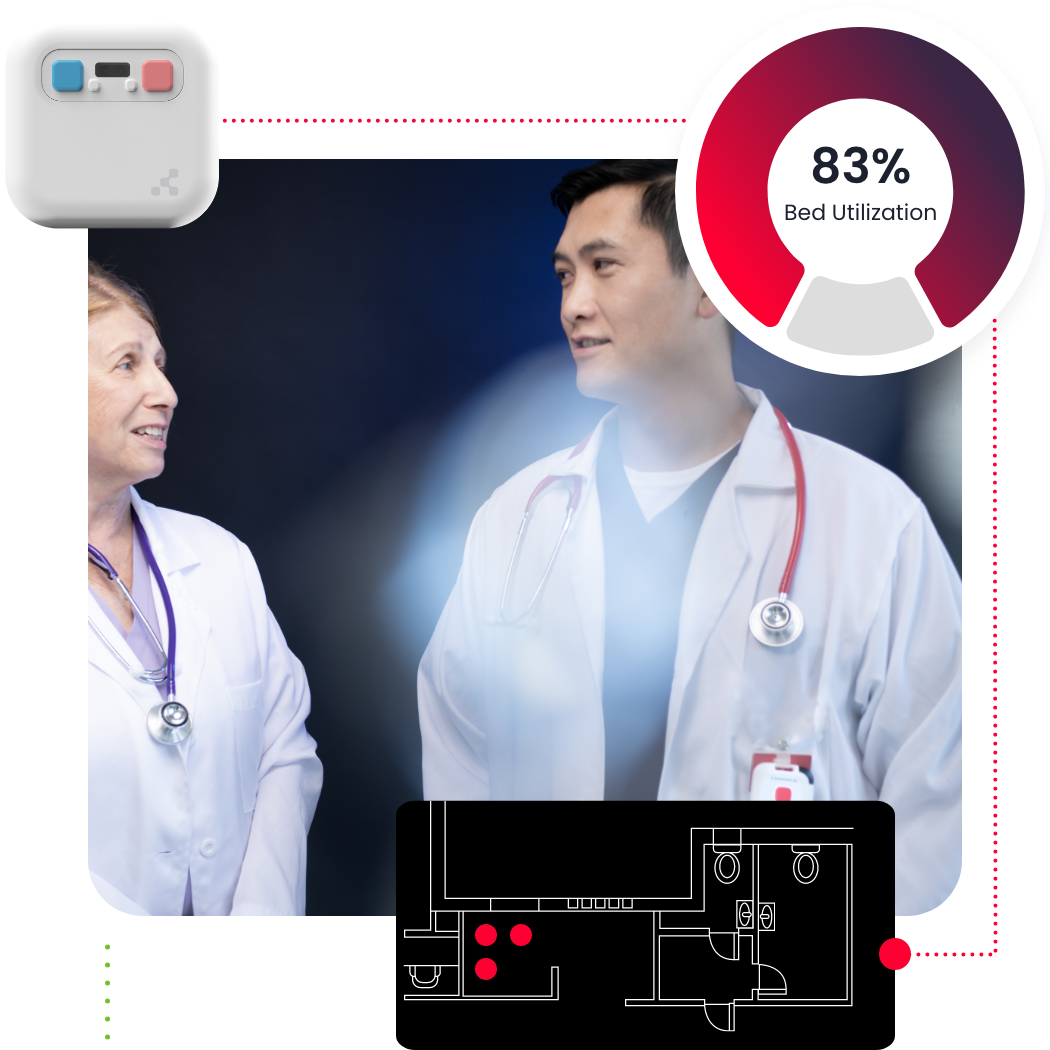Hospitals today manage thousands of devices worth millions of dollars. From infusion pumps and ventilators to wheelchairs and beds, every day these assets must be available, operational, and in the right place. Each device has a recommended maintenance schedule. High-volume devices such as IV pumps have to be maintained annually. In a typical 200-bed hospital, over 2,000 man-hours can be wasted each year searching for a specific medical device. That averages over five hours per day. In addition, 10-15% of medical devices miss a Performance Management (PM) cycle because of lack of location visibility.

As hospital systems grow ever more complex, the need for asset management in healthcare goes far beyond simply tracking location. Today’s hospitals require full-lifecycle management to optimize utilization, cut cost, support care delivery, and reduce waste.
As asset management and hospitals evolve, many institutions realize that asset tracking alone is no longer enough. Visibility into where assets are is important. But strategic asset management in hospitals requires understanding not only location, but also condition, lifecycle, utilization, maintenance, compliance, and cost. Asset tracking is part of the story; asset management is the bigger picture.
What is Asset Management in Healthcare?
At its simplest: asset tracking shows you where a device is today. Asset management tells you how useful it is, whether it is properly maintained, when it should be retired, whether you’re over- or under-invested, and how all of this aligns with clinical, operational and financial goals. An asset management and tracking system should enable hospitals to locate assets, measure utilization, monitor condition, trigger maintenance, retire when necessary, and forecast capital requirements.
Asset management in healthcare covers much more than simply knowing where something is. It involves inventory, utilization, maintenance, lifecycle, compliance and financial oversight of medical devices and equipment. Terms like medical equipment asset management, asset management equipment, and asset management and tracking systems reflect this broader scope.
Asset tracking is operational and tactical. For example, “Find the IV pump.” By contrast, asset management is strategic. For example, “How many pumps do we need? Are they being used? When must we retire them?” The differentiation matters for healthcare leaders who want to turn equipment from cost sinks into care enablers.
Why is Asset Management Important for Hospitals?
Asset management matters because it stands at the intersection of cost, care, compliance and capacity.
- Financial impact: Hospitals lose millions annually to equipment shrinkage, misplacement and over-purchasing. An average 200-bed hospital loses 4-7% of devices annually. Without proper asset management, organizations often buy duplicates rather than reallocating existing devices, and thus inflate capital expenditures (CAPEX) unnecessarily.
- Operational efficiency: Staff spends too much time searching for equipment, which leads to lost productivity and delays in care. Kontakt.io has experienced that a typical nurse might waste 6% of their shift searching for equipment. Effective asset management improves staff productivity and reduces search/browser time.
- Clinical readiness and safety: When equipment isn’t available or isn’t maintained, patient care suffers. 65% of high-volume devices like IV pumps are not utilized at any given time. Asset management helps ensure the right tools are ready when needed, contributing to improved patient outcomes.
- Compliance and regulation: Hospitals must comply with requirements from bodies likeThe Joint Commission, Centers for Medicare & Medicaid Services (CMS)and the Food and Drug Administration (FDA). Effective asset management systems support auditing, documentation and regulatory tracking.
- Strategic planning: Asset management enables forecasting and capital planning. Instead of reacting to urgent equipment needs, hospitals can anticipate when devices will need replacement and budget accordingly, thereby aligning with broader organizational goals.
How Asset Management and Tracking Systems Work
Hospitals deploy a combination of sensors, tags and software to track assets. For example, real-time location systems (RTLS) capture where a device is, and feed that information into dashboards. That is part of an asset location tracking system or asset location services environment.
In an asset management environment, real-time visibility is just the beginning. The data flows into analytics and workflows that support asset management tracking system functions: utilization reporting, maintenance scheduling, lifecycle alerts, inventory optimization, and compliance tracking. This software, sometimes called asset management software for hospitals, is designed to shift from simply appear-and-track to optimize-and-manage.
For example, a hospital may tag all infusion pumps with Bluetooth Low Energy (BLE) or Radio Frequency Identification (RFID) sensors. The tag broadcasts location and status. The centralized system reviews usage patterns, triggers preventive maintenance, identifies assets that are under-utilized, and recommends reducing inventory. A true asset management and tracking solution integrates tags, dashboards, analytics and workflows.

What are the Parts of Asset Management in Healthcare?
A robust asset management program in hospitals includes several interconnected components:
- Asset inventory and tracking: Cataloguing assets, tagging them, and capturing location and status.
- Utilization management: Measuring how often and when devices are used, identifying idle equipment and right-sizing inventory.
- Maintenance management (preventive/predictive): Scheduling and tracking equipment maintenance, calibrations, safety checks.
- Lifecycle management (acquisition to retirement): Understanding when devices should be replaced, depreciated, or retired to optimize cost and performance.
- Compliance and auditing: Ensuring documentation for regulatory standards, tracking tag history, audit trails and device certification.
- Financial oversight: Linking asset data to budgets, CAPEX planning, and performance metrics to align equipment investment with hospital goals.
A true asset management system covers all these categories, not just the obvious mobile devices.
What Types of Assets Can Be Managed?
Hospitals manage a wide range of assets, each of which benefits from a management approach:
- Clinical assets: Infusion pumps, ventilators, imaging equipment, patient monitors.
- Emergency equipment: Automated External Defibrillator (AEDs), crash carts, defibrillators.
- Surgical instruments: Specialized tools, sterilization trays.
- Non-clinical but essential equipment: IT equipment, mobile workstations, supply carts.
- Environmental/pharmaceutical assets: Temperature-sensitive devices, freezers, monitoring equipment.
A true asset management system covers all these categories, not just the obvious mobile devices.
Technologies Behind Medical Equipment Asset Management
Modern systems rely on several technologies. RTLS using BLE, RFID, or UWB offer tag-based location tracking. Internet of Medical Things (IoMT) sensors can provide usage, condition, and environmental metrics. Asset management software for hospitals provides dashboards, analytics and integration into systems like Computerized Maintenance Management System (CMMS) or Electronic Health Records (HHR).
Bluetooth-enabled tags are popular for cost-efficient, scalable deployments. Integration capabilities (cloud, mobile, APIs) are key so that asset tracking and management work across systems. BLE consistently delivers room-level accuracy within 1 to 3 meters, which is ideal for locating mobile medical equipment. Its exceptionally low-power consumption enables tag batteries to last multiple years, cutting maintenance time and cost. Asset Tag 2 batteries from Kontakt.io can last up to 8 years and are replaced as part of a managed service.
Scalable systems enable expansion across departments and buildings. This allows asset management and tracking across entire hospital networks.
![]()
What are Benefits of Asset Management in Healthcare?
Because healthcare is such a capital-intensive industry where each bed can cost $5 to $6 million, utilization and asset efficiency matter deeply. Maximizing utilization of high-cost resources is paramount to financial sustainability and effective care delivery.
In order to maximize utilization, healthcare systems need real-time visibility of their inventory. Hospitals not only need to understand what equipment they have, but also where it is, where it’s needed, what condition it is in, and, ultimately, where it will be needed next. Enhanced asset management, powered by RTLS data and AI analytics, can deliver operational efficiencies.
These are the core benefits hospitals realize:
- Reduced equipment costs and CAPEX through better utilization and avoided duplication.
- Higher utilization rates of mobile equipment.
- Faster care delivery and shorter patient wait times, when equipment is available when needed.
- Extended asset lifespan via preventive and predictive maintenance.
- Increased staff efficiency and morale, since less time is spent searching for equipment.
- Better forecasting and data-driven capital planning, aligning equipment investment with hospital strategy.
Challenges and Constraints in Healthcare Asset Management
Despite the benefits, hospitals face several barriers:
- Manual processes and siloed systems hamper visibility and action.
- Staff hoarding or asset theft complicates inventory accuracy.
- Maintenance scheduling can be complex across device types and regulations.
- Budget constraints often prevent full deployment of asset management systems.
- Multi-site complexity (campuses, off-site clinics) makes standardization hard.
Addressing these challenges requires an enterprise-grade solution that can scale, integrate and deliver measurable ROI.
How to Choose the Right Asset Management Solution
When selecting an asset management solution, hospital executives should look for:
- Scalability across sites and departments, not just a pilot.
- Accurate and reliable location tracking (asset tracking and management).
- Ease of use for staff to ensure adoption (mobile apps, simple workflows).
- Integration capabilities with existing systems (EHR, CMMS, procurement).
- Feature set that includes utilization analytics, compliance tracking, mobile access and reporting.
- Robust security and compliance, including Health Insurance Portability and Accountability Act (HIPAA) and System and Organization Controls 2 (SOC 2).

Intelligent Orchestration Platform from Kontakt.io
The Intelligent Orchestration Platform from Kontakt.io optimizes asset management for healthcare, cuts costs, and reduces waste. Kontakt.io’s solution for hospital asset management ensures that every resource is in the right place, at the right time, enhancing patient outcomes. The AI-powered platform delivers real-time visibility into asset location, status and utilization, helping hospitals eliminate unnecessary purchases and rentals while optimizing inventory. The solution’s plug-and-play architecture reduces deployment time from months to days, turning asset visibility into measurable results fast.
With system-wide Intelligent Orchestration deployment, hospitals often achieve 10X ROI, increase asset utilization by 30%, and save millions annually. For example, with optimized inventory, a hospital can avoid major purchases, reduce rental costs, and redirect staff effort toward patient care rather than equipment search. The shift from equipment search to patient focus is a key differentiator.
The U.S. Department of Veterans Affairs uses Kontakt.io’s Intelligent Orchestration Platform to modernize asset management and elevate the patient experience. Leveraging their existing Bluetooth LE network, the VA has gained real-time visibility into thousands of assets, cutting search times and optimizing resource allocation. This initiative not only streamlined hospital workflows, but also improved care delivery.

Similarly, Riverside Healthcare, a 300-bed award-winning trauma hospital, uses the platform to track both medical devices and patient movement in real time. The plug-and-play Bluetooth LE solution recovered the equivalent of a full-time staff position previously lost to equipment searches and strengthened patient safety through automated elopement alerts. With full visibility across assets and people, Riverside has improved staff productivity, efficiency, and care quality.
Hospital asset management and tracking need not be a long-term distant ambition. With the right partner, hospitals can deploy quickly, scale across sites, and begin realizing benefits in months. Kontakt.io’s practical approach makes the journey from asset tracking to asset management real, sustainable and strategic.
In Summary
Asset management in healthcare is about more than tracking location. It’s about optimizing how devices are used, maintained and replaced. It connects cost, care, compliance and capacity in one strategic framework. By differentiating asset tracking from asset management, hospitals can shift from reactive equipment searches to proactive utilization, from disconnected dashboards to integrated workflows, and from wasted inventory to optimized care delivery.
If your hospital is ready to see how effective asset management can drive cost savings, improve utilization and support better outcomes, Kontakt.io stands ready to help. With a scalable, healthcare-ready solution and proven ROI, the transition from tracking to management has never been more compelling.


